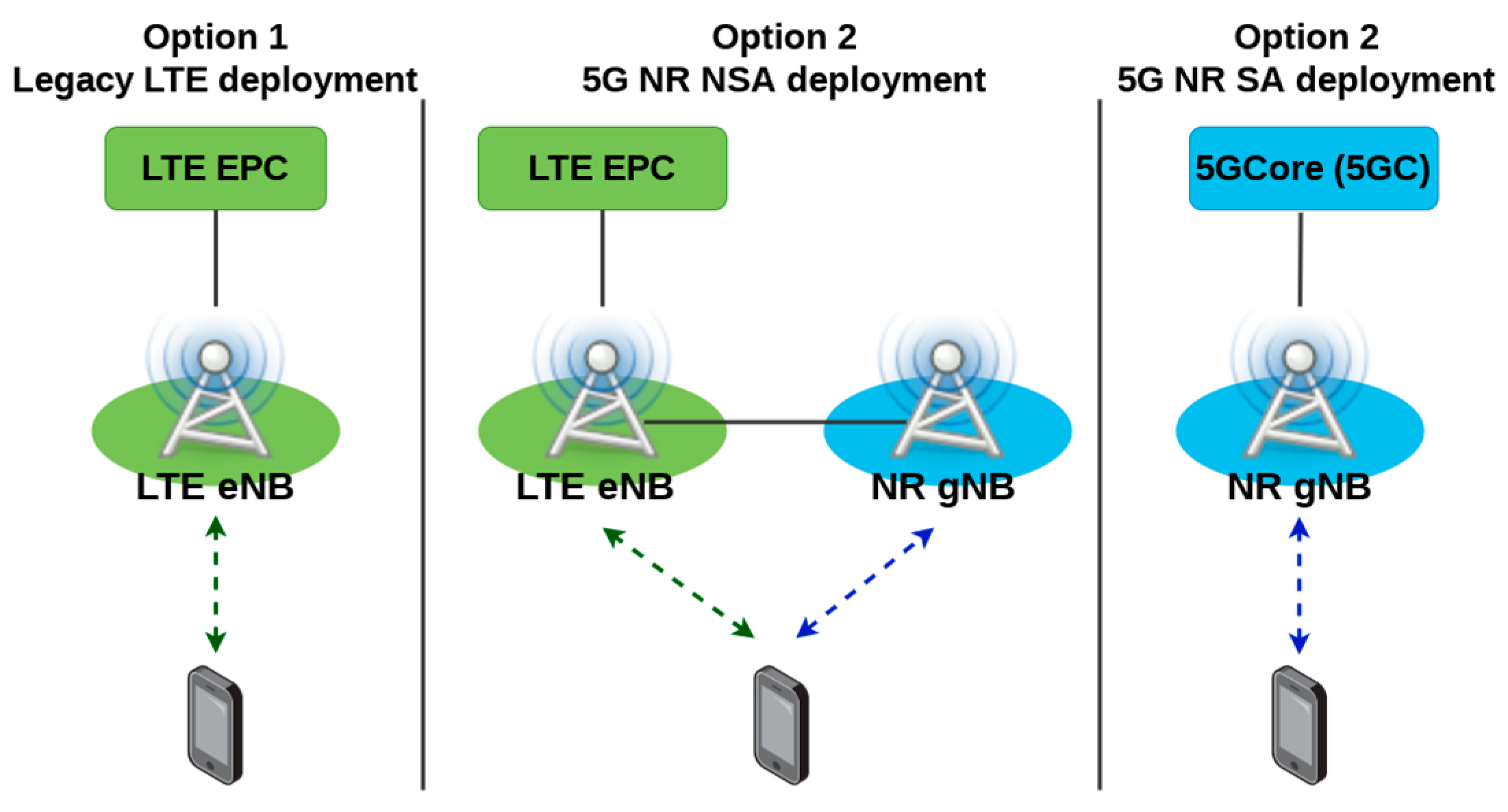End-to-End Performance Evaluation of MEC Deployments in 5G Scenarios
Abstract
1. Introduction
2. Multi-Access Edge Computing in 4G/5G
2.1. Background on Multi-Access Edge Computing
2.2. MEC Deployment in Cellular Networks
3. Co-Simulation Based E2E Evaluation Framework
3.1. Simu5G
3.2. CoFluent
3.3. Co-Simulation Framework
- Step 1:
- We instantiate a scenario, complete with UE location and mobility, and we run it in Simu5G. In the latter, UEs will generate application-level messages, to be transmitted on the UL leg of the radio access network, destined to the collector. These messages will accumulate delay on their way up, due to user contention, protocol delays, channel quality impairments, etc. The traffic that arrives to the collector (i.e., that exits the RAN) leaves Simu5G as well. We timestamp the traffic, and we log both timestamp and message sizes to Logfile#1 file. More specifically, we log both the simulated time at which a message is generated at the UE, and the simulated time at which it reaches the collector. These times are expressed in Simu5G’s units.
- Step 2:
- We run CoFluent, using Logfile#1 as an input. The MEC elements modeled in CoFluent process the requests generated by the UEs, and the MEC server generates replies accordingly. These replies will contain a payload, which depends on the traffic model used within CoFluent. These replies are sent back to the RAN. Similar to step 1, replies are timestamped and logged in the Logfile#2 file. In the latter, timestamps are expressed in CoFluent’s units. During step 2, time is spent traversing the necessary MEC elements, e.g., queueing up at contention points.
- Step 3:
- We run Simu5G once more, using the same scenario as for step 1. More specifically, the UE location and mobility are the same. We now use Logfile#2 to generate the replies to be transmitted to the UEs using the DL leg of the RAN. As in step 1, replies accumulate delay due to interference, channel issues, congestion and protocol mechanisms.
- An application that issues service requests periodically at a UE, written in C++.
- A C++ collector application that collects all the UE messages (after they have got to the respective BSs) and prints Logfile#1.
- A program written in python, simu2mec.py, that converts Logfile#1 to a structured JSON file, to be used as an input to CoFluent.
- A program written in python, mec2simu.py, that parses the MEC packet trace produced by CoFluent, and generates a structured JSON file, which specifies for each packet, its ID, the ID of the UE that generated it, and the timestamp.
- A C++ application that takes the above JSON file as an input and generates a trace of DL messages accordingly. These messages are those that will be injected at step 3, to reach the interested UEs via their serving BSs.
- A C++ application, running on UEs, that collects responses and generates reports (e.g., by computing the RTT of each request and assembling it with some aggregator, say the mean value).
4. Performance Evaluation
- 5G NSA deployment (Figure 8, center): the BSs are again LTE eNBs and each of the three central cells also has a gNB placed in the center of the hexagons, connected to the corresponding eNB via X2 and radiating power according to an omnidirectional pattern. The LTE eNBs are connected to a distributed EPC site in proximity of the RAN. Both S-GW and P-GW, as well as the MEC, are considered as virtual network functions (VNFs). Since the path between the RAN and the MEC involves two VNFs, we assume a one-way latency of 200 µs [32]. For the X2 interface, we assume 5 ms latency [33,34].
- 5G SA deployment (Figure 8, bottom): the BSs are gNBs connected to a distributed 5G Core (5GC). Again, the MEC is a VNF connected to (at least) a UPF, acting as PDU session anchor in the 5GC, and terminating to the data network. Since there is only one VNF between the RAN and the MEC, the considered one-way latency is 100 µs.
5. Conclusions and Future Work
Author Contributions
Funding
Conflicts of Interest
References
- Intel White Paper. Edge Computing: From Standard to Actual Infrastructure Deployment and Software Development. Available online: https://intel.ly/2Wx7Gy4 (accessed on 10 November 2020).
- ETSI MEC (Multi-Access Edge Computing). Available online: https://www.etsi.org/technologies/multi-access-edge-computing (accessed on 10 November 2020).
- Sabella, D.; Vaillant, A.; Kuure, P.; Rauschenbach, U.; Giust, F. Mobile-Edge Computing Architecture: The role of MEC in the Internet of Things. IEEE Consum. Electron. Mag. 2016, 5, 84–91. [Google Scholar] [CrossRef]
- ETSI GS MEC 003 V2.1.1 (2019-01). Multi-access Edge Computing (MEC); Framework and Reference Architecture. January 2019. Available online: https://bit.ly/2yOmYps (accessed on 10 November 2020).
- ETSI GS MEC 009 V2.1.1 (2019-01). Multi-Access Edge Computing (MEC); General Principles for MEC Service APIs. Available online: https://bit.ly/2zzYCj6 (accessed on 10 November 2020).
- ETSI White Paper No. 24. MEC Deployments in 4G and Evolution Towards 5G, First Edition—February 2018. Available online: https://bit.ly/2T5AKe7 (accessed on 10 November 2020).
- ETSI White Paper No. 28. MEC in 5G Networks. June 2018. Available online: https://bit.ly/3bzCLFI (accessed on 10 November 2020).
- Emara, M.; Filippou, M.C.; Sabella, D. MEC-Assisted End-to-End Latency Evaluations for C-V2X Communications. In Proceedings of the 2018 European Conference on Networks and Communications (EuCNC), Ljubljana, Slovenia, 18–21 June 2018; pp. 1–9. [Google Scholar]
- Pencheva, E.; Atanasov, I.; Velkova, D.; Trifonov, V. Evaluation of Multi-access Edge Computing Deployment Scenarios. In Proceedings of the 2019 9th Annual Information Technology, Electromechanical Engineering and Microelectronics Conference (IEMECON), Jaipur, India, 13–15 March 2019; pp. 155–160. [Google Scholar]
- Patriciello, N.; Lagen, S.; Bojovic, B.; Giupponi, L. An E2E simulator for 5G NR networks. Simul. Model. Pract. Theory 2019, 96, 101933. [Google Scholar] [CrossRef]
- Nardini, G.; Virdis, A.; Stea, G.; Buono, A. SimuLTE-MEC: Extending SimuLTE for Multi-Access Edge Computing. EPiC Ser. Comput. 2018, 56, 35–42. [Google Scholar] [CrossRef]
- Castañé, G.G.; Nuñez, A.; Carretero, J. iCanCloud: A Brief Architecture Overview. In Proceedings of the 2012 IEEE 10th International Symposium on Parallel and Distributed Processing with Applications, Leganes, Spain, 10–13 July 2012; pp. 853–854. [Google Scholar]
- Kliazovich, D.; Bouvry, P.; Khan, S.U. GreenCloud: A Packet-Level Simulator of Energy-Aware Cloud Computing Data Centers. J. Supercomput. 2010, 62, 1–5. [Google Scholar]
- Available online: https://www.intel.com/content/www/us/en/cofluent/overview.html (accessed on 10 November 2020).
- ETSI GS MEC 002. Mobile Edge Computing (MEC); Technical Requirements; 2016-03. Available online: https://www.etsi.org/deliver/etsi_gs/MEC/001_099/002/01.01.01_60/gs_MEC002v010101p.pdf (accessed on 10 November 2020).
- Sabella, D.; Reznik, A.; Frazao, R. Multi-Access Edge Computing in Action; Informa UK Limited: London, UK, 2019. [Google Scholar]
- Sabella, D.; Nikaein, N.; Huang, A.; Xhembulla, J.; Malnati, G.; Scarpina, S. A Hierarchical MEC Architecture: Experimenting the RAVEN Use-Case. In Proceedings of the 2018 IEEE 87th Vehicular Technology Conference (VTC Spring), Porto, Portugal, 3–6 June 2018; pp. 1–5. [Google Scholar] [CrossRef]
- GSMA. Operator Requirements for 5G Core Connectivity Options. May 2019. Available online: https://bit.ly/2WOgiiM (accessed on 10 November 2020).
- 3GPP RP-161266. Architecture Configuration Options for NR. Available online: https://portal.3gpp.org/ngppapp/CreateTDoc.aspx?mode=view&contributionUid=RP-161266 (accessed on 10 November 2020).
- Intel 5G Connected Vehicles Webinar, Referring to the Study from Strategy Analytics. Accelerating the Future: The Economic Impact of the Emerging Passenger Economy. June 2017. Available online: https://intel.ly/2Wwqpdt (accessed on 10 November 2020).
- Nardini, G.; Stea, G.; Virdis, A.; Sabella, D. Simu5G: A System-level Simulator for 5G Networks. In Proceedings of the 10th International Conference on Simulation and Modeling Methodologies, Technologies and Applications, Paris, France, 8–10 July 2020. [Google Scholar]
- Nardini, G.; Stea, G.; Virdis, A.; Sabella, D.; Thakkar, P. Using Simu5G as a Realtime Network Emulator to Test MEC Apps in an End-To-End 5G Testbed. In Proceedings of the 2020 IEEE 31st Annual International Symposium on Personal, Indoor and Mobile Radio Communications, London, UK, 31 August 2020. [Google Scholar]
- Nardini, G.; Sabella, D.; Stea, G.; Thakkar, P.; Virdis, A. Simu5G–An OMNeT++ Library for End-to-End Performance Evaluation of 5G Networks. IEEE Access 2020, 8, 181176–181191. [Google Scholar] [CrossRef]
- Simu5g Website. Available online: http://simu5g.org (accessed on 10 November 2020).
- OMNeT++ Website. Available online: https://omnetpp.org (accessed on 10 November 2020).
- Virdis, A.; Stea, G.; Nardini, G. Simulating LTE/LTE-Advanced Networks with SimuLTE. In Advances in Intelligent Systems and Computing; Springer Science and Business Media LLC: Heidelberg, Germany, 2015; Volume 402, pp. 83–105. [Google Scholar]
- SimuLTE Website. Available online: http://simulte.com (accessed on 10 November 2020).
- INET Library Website. Available online: https://inet.omnetpp.org (accessed on 10 November 2020).
- 3GPP TS 37.340 v16.1.0. Evolved Universal Terrestrial Radio Access (E-UTRA) and NR; Multi-Connectivity; Stage 2 (Rel. 16). March 2020. Available online: https://portal.3gpp.org/desktopmodules/Specifications/SpecificationDetails.aspx?specificationId=3198 (accessed on 10 November 2020).
- Pratschner, S.; Tahir, B.; Marijanovic, L.; Mussbah, M.; Kirev, K.; Nissel, R.; Schwarz, S.; Rupp, M. Versatile mobile communications simulation: The Vienna 5G Link Level Simulator. EURASIP J. Wirel. Commun. Netw. 2018, 2018, 226. [Google Scholar] [CrossRef]
- Virdis, A.; Nardini, G.; Stea, G.; Shi, Y.; Bian, Z. A Co-Simulation Framework to Evaluate Edge Deployment Options and Performance. In Proceedings of the 2020 IEEE International Conference on Communications Workshops (ICC Workshops), Dublin, Ireland, 7–11 June 2020. [Google Scholar]
- Filippou, M.C.; Sabella, D.; Riccobene, V. Flexible MEC service consumption through edge host zoning in 5G networks. In Proceedings of the 2019 IEEE Wireless Communications and Networking Conference Workshop (WCNCW), Marrakech, Morocco, 15–18 April 2019. [Google Scholar]
- Wang, H.; Rosa, C.; Pedersen, K.I. Dual connectivity for LTE-advanced heterogeneous networks. Wirel. Netw. 2015, 22, 1315–1328. [Google Scholar] [CrossRef]
- Michalopoulos, D.S.; Maeder, A.; Kolehmainen, N. 5G Multi-Connectivity with Non-Ideal Backhaul: Distributed vs Cloud-Based Architecture. In Proceedings of the 2018 IEEE Globecom Workshops (GC Wkshps), Abu Dhabi, UAE, 9–13 December 2018; pp. 1–6. [Google Scholar] [CrossRef]
- 3GPP TR 36.873 v12.7.0. Study on 3D Channel Model for LTE. December 2017. Available online: https://portal.3gpp.org/desktopmodules/Specifications/SpecificationDetails.aspx?specificationId=2574 (accessed on 10 November 2020).
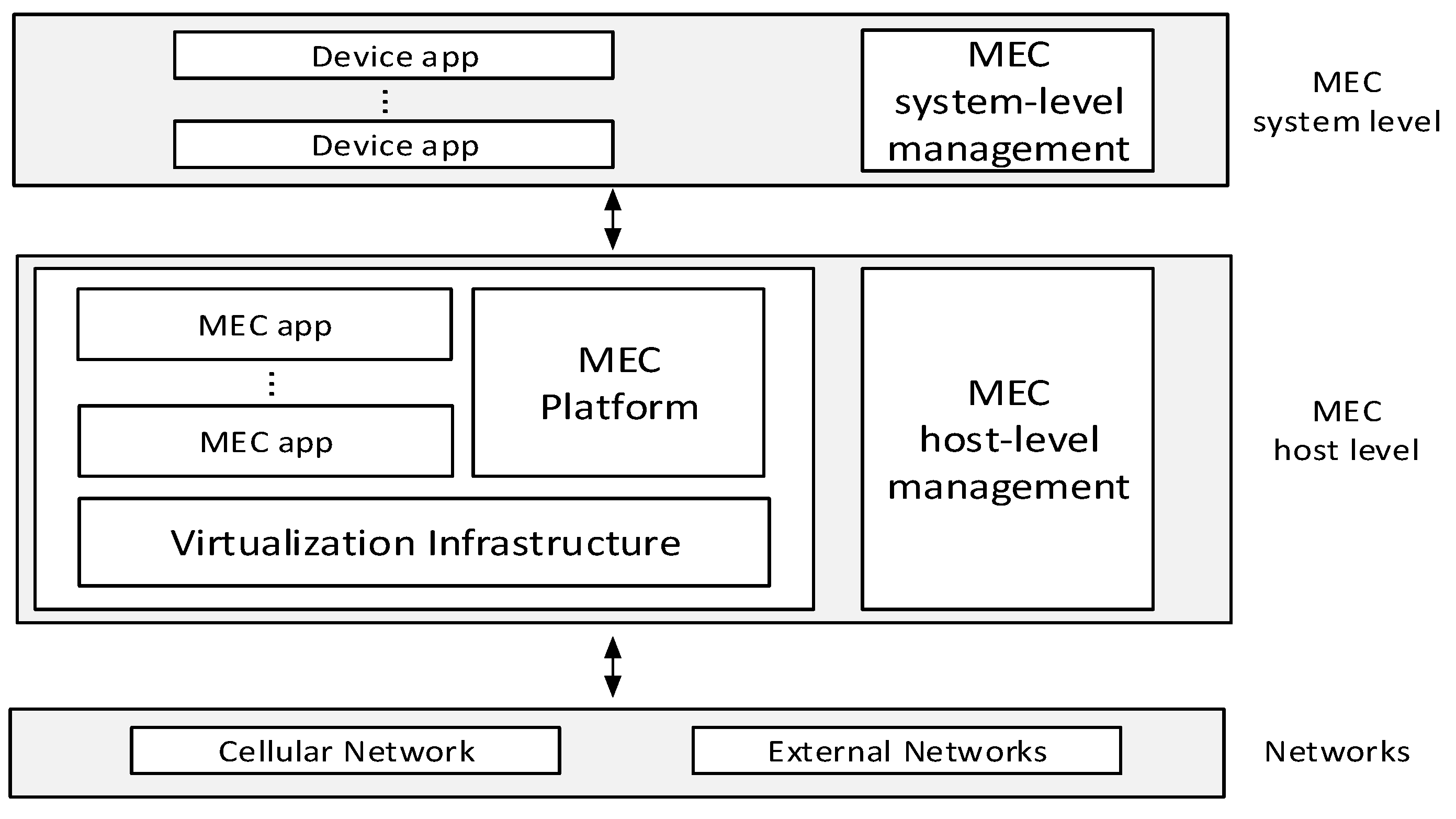
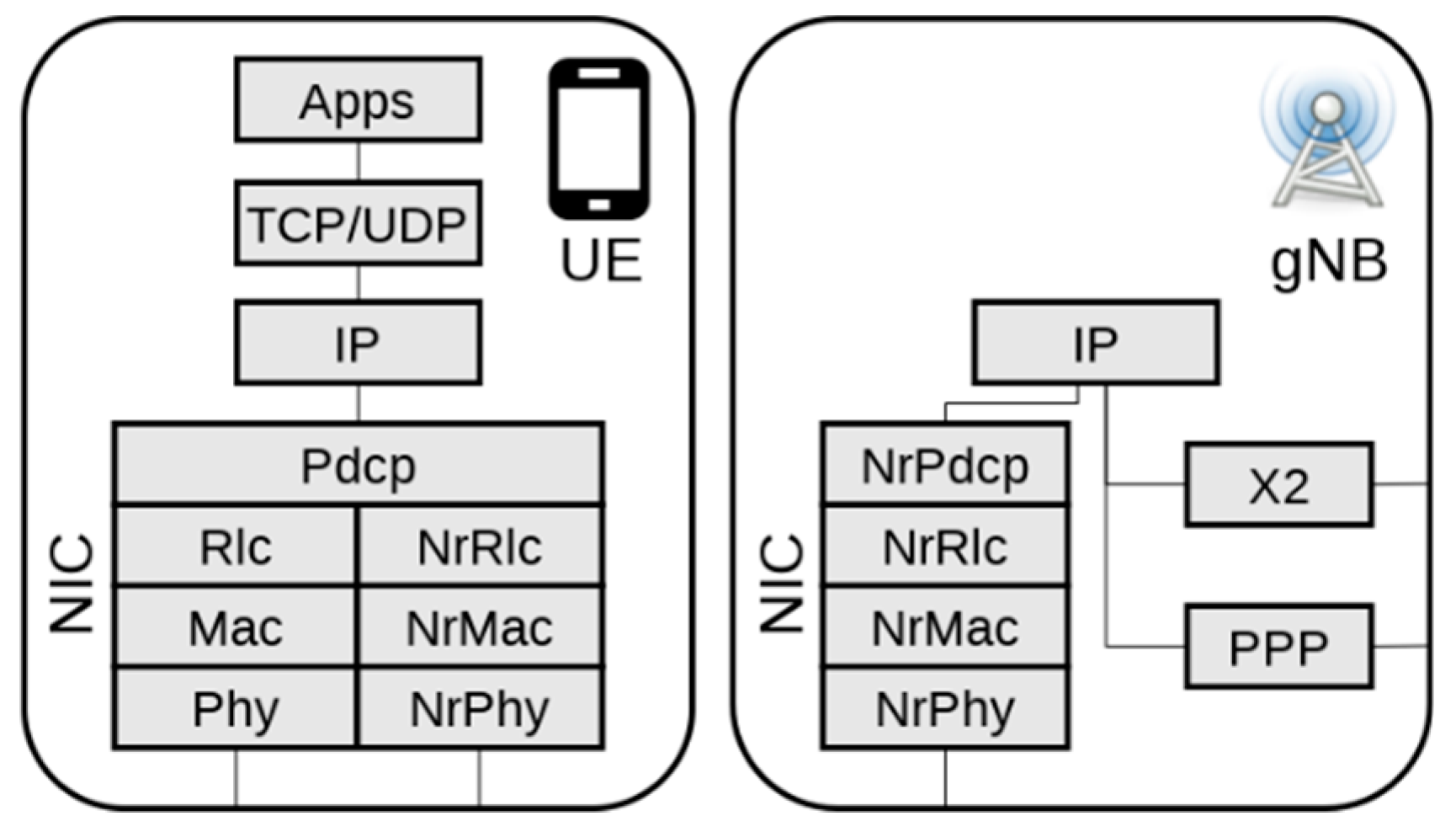
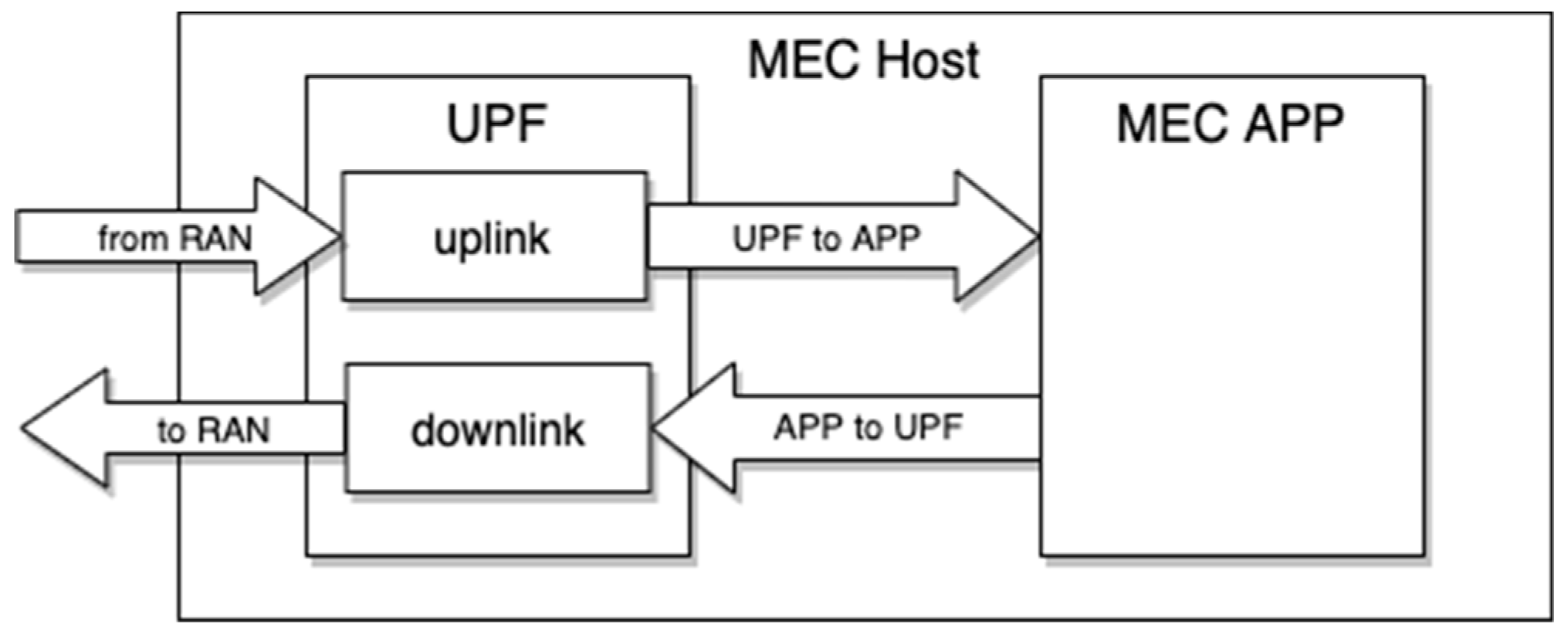
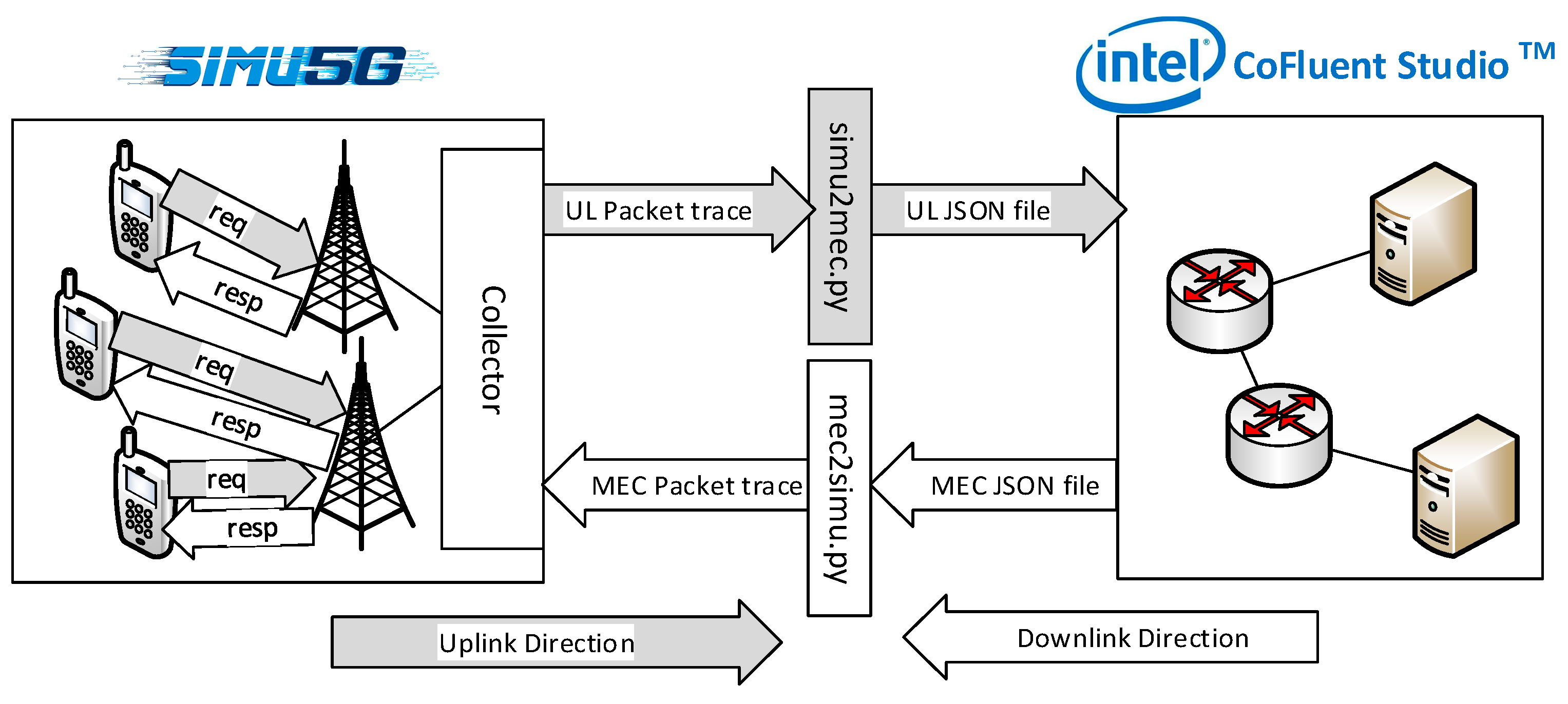
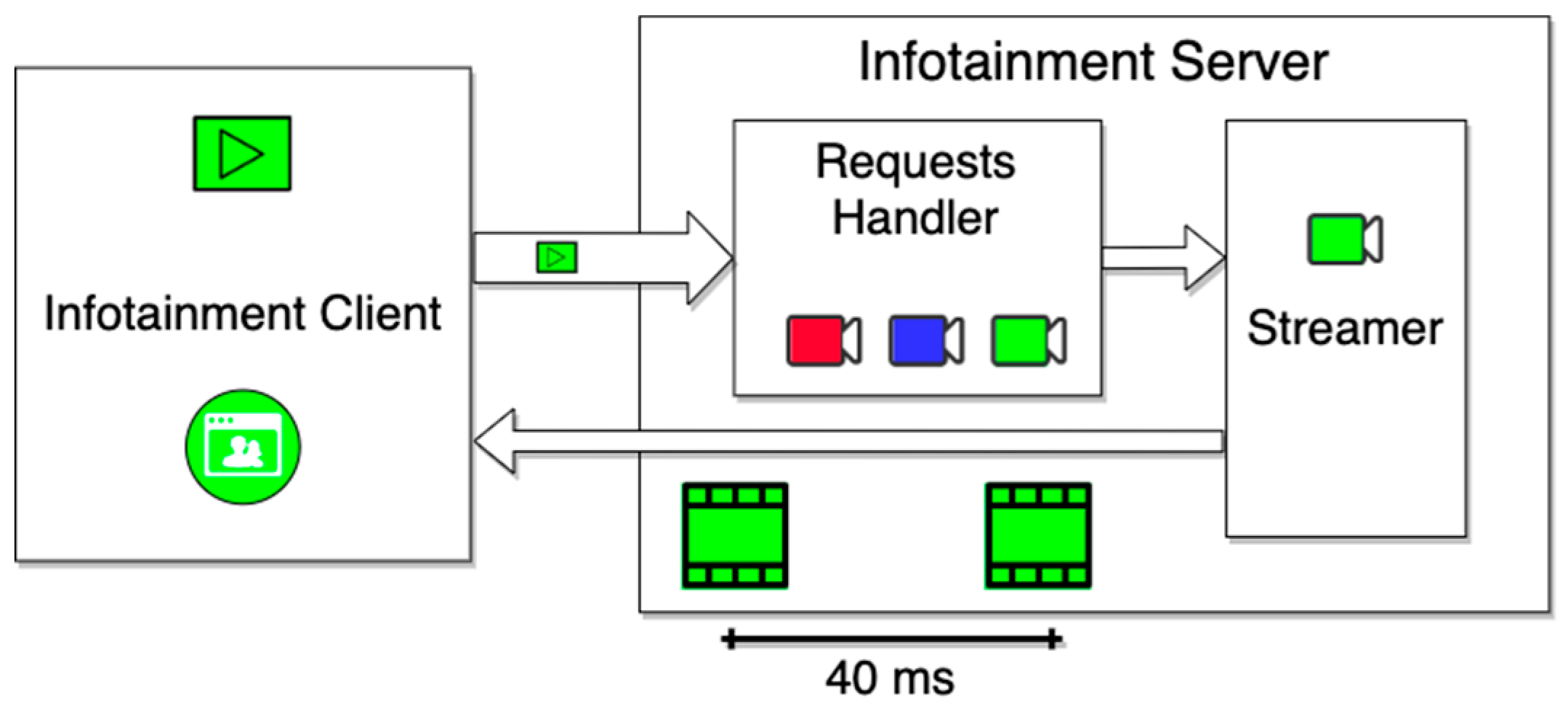
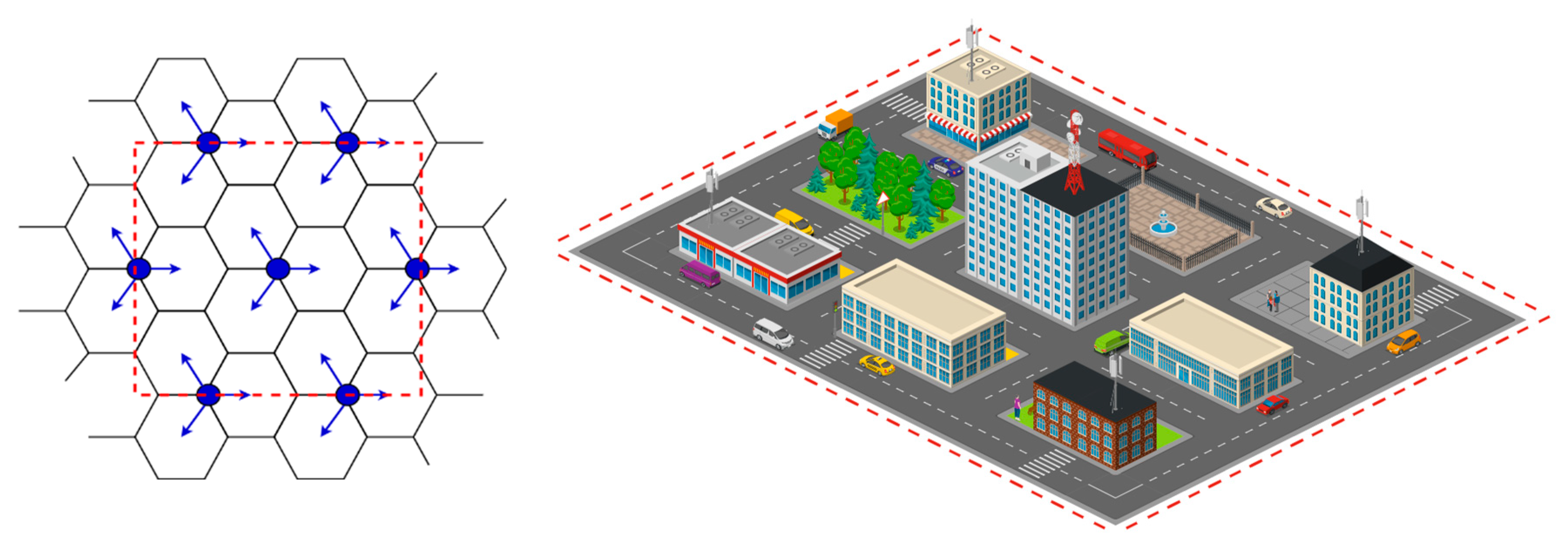
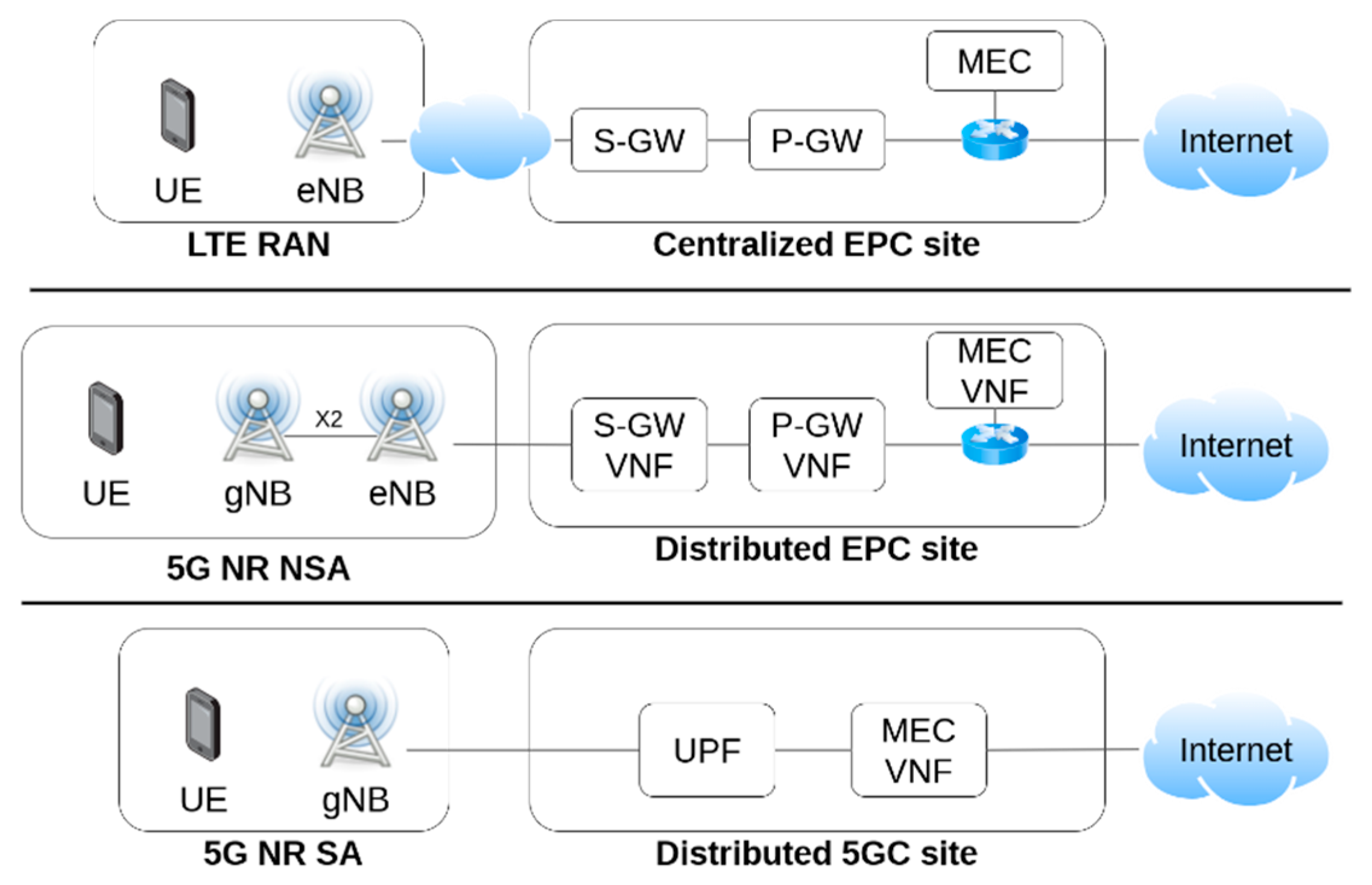
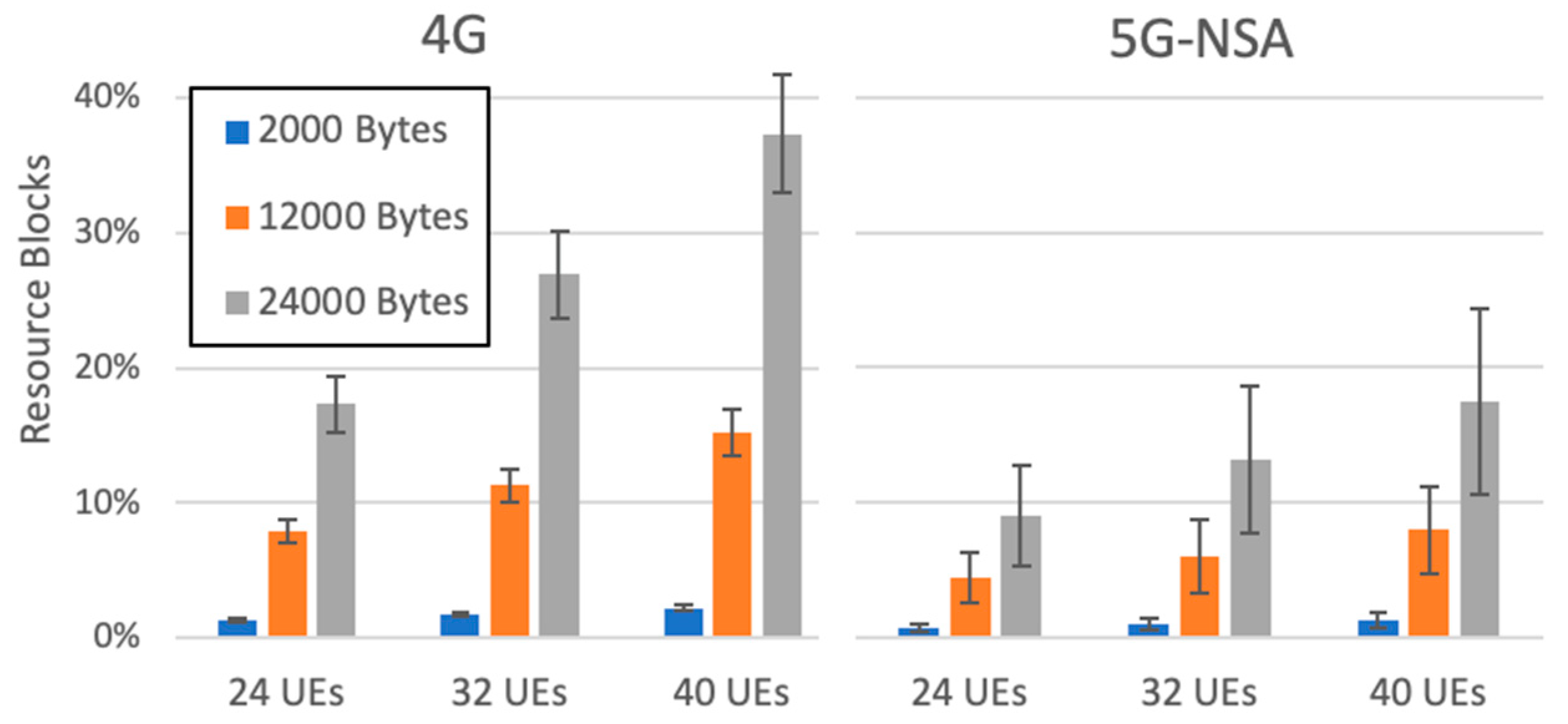



| Video Format | Bitrate | Frame Size (Fixed) |
|---|---|---|
| 240p | 400 kbps | 2000 Bytes |
| 720p | 2400 kbps | 12,000 Bytes |
| Video Format | Bitrate |
|---|---|
| Bandwidth | 20 MHz (100 Resource Blocks) |
| Carrier Frequency | 2 GHz |
| 6 GHz for gNBs in NSA | |
| Numerology index (5G only) | 2 (60-kHZ subcarrier spacing) |
| Tx Power | BS: 46 dBm; UE: 23 dBm |
| Fading effects | Enabled |
| Path loss model | [35] |
| UE mobility | Linear, ~ m/s |
| CN latency (one-way) | LTE: 15 ms |
| 5G: 200 µs (NSA), 100 µs (SA) | |
| X2 latency | 5 ms |
| Simulation time | 200 s |
| UPF UL/DL bandwidth | 100 Gb/s |
| UPF-APP and APP-UPF delay | 5.4 µs |
| REQ processing time | 50 µs |
| Frame creation time | 200 µs |
| Frame size | {2000, 12,000, 24,000} bytes |
| Video duration | 8 s |
| Request period | 12 s |
Publisher’s Note: MDPI stays neutral with regard to jurisdictional claims in published maps and institutional affiliations. |
© 2020 by the authors. Licensee MDPI, Basel, Switzerland. This article is an open access article distributed under the terms and conditions of the Creative Commons Attribution (CC BY) license (http://creativecommons.org/licenses/by/4.0/).
Share and Cite
Virdis, A.; Nardini, G.; Stea, G.; Sabella, D. End-to-End Performance Evaluation of MEC Deployments in 5G Scenarios. J. Sens. Actuator Netw. 2020, 9, 57. https://doi.org/10.3390/jsan9040057
Virdis A, Nardini G, Stea G, Sabella D. End-to-End Performance Evaluation of MEC Deployments in 5G Scenarios. Journal of Sensor and Actuator Networks. 2020; 9(4):57. https://doi.org/10.3390/jsan9040057
Chicago/Turabian StyleVirdis, Antonio, Giovanni Nardini, Giovanni Stea, and Dario Sabella. 2020. "End-to-End Performance Evaluation of MEC Deployments in 5G Scenarios" Journal of Sensor and Actuator Networks 9, no. 4: 57. https://doi.org/10.3390/jsan9040057
APA StyleVirdis, A., Nardini, G., Stea, G., & Sabella, D. (2020). End-to-End Performance Evaluation of MEC Deployments in 5G Scenarios. Journal of Sensor and Actuator Networks, 9(4), 57. https://doi.org/10.3390/jsan9040057







